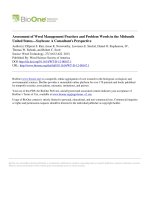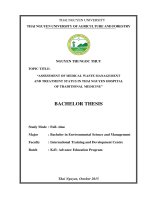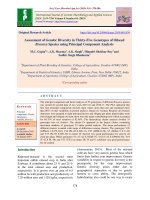Assessment of genetic variability, heritability and genetic advance in Indian mustard [Brassica juncea L. Czern & Coss.]
Bạn đang xem bản rút gọn của tài liệu. Xem và tải ngay bản đầy đủ của tài liệu tại đây (206.35 KB, 6 trang )
Int.J.Curr.Microbiol.App.Sci (2018) 7(11): 13-18
International Journal of Current Microbiology and Applied Sciences
ISSN: 2319-7706 Volume 7 Number 11 (2018)
Journal homepage:
Original Research Article
/>
Assessment of Genetic Variability, Heritability and Genetic Advance in
Indian Mustard [Brassica juncea L. Czern & Coss.]
Sarvesh Kr. Maurya*, K.N. Maurya, Kanhaiya Lal, Yogendra Singh, Sujit Singh,
Brijesh Dixit and Soni Singh
Department of Genetics and Plant Breeding, Narendra Deva University of Agriculture and
Technology, Kumarganj, Faizabad-224229 (U.P.) India
*Corresponding author
ABSTRACT
Keywords
Indian mustard (Brassica
juncea L. Czern & Coss.),
Selection parameters,
Genetic variability,
Heritability and genetic
advance
Article Info
Accepted:
04 October 2018
Available Online:
10 November 2018
An experiment was made to assess extant of genetic variability among fifty germplasm
accessions of Indian mustard with three check varieties for various quantitative characters,
heritability and genetic advance also estimated for such characters. Analysis of variance
revealed highly significant differences for all the characters. The genotypes showed
moderate to high level of genotypic coefficient of variance (GCV) and phenotypic
coefficient of variance (PCV). In general phenotypic coefficient of variance was found to
be higher than their genotypic coefficient of variance but the extent was quite small,
indicating very less environmental influence on the expression of the characters.
Genotypic coefficient of variation (GCV) was found to be higher for 1000-seed weight
(24.33), biological yield per plant (22.47), secondary branches plant (22.41), seed yield per
plant (19.75). Heritability and genetic advance are important selection parameters. High
heritability estimates were observed for biological yield, plant height, oil content, main
raceme length, 1000-seed weight, siliqua on main raceme, secondary branches per plant,
seed yield per plant and days to maturity. The expected genetic advance as percent of
mean was high for 1000-seed weight, biological yield, secondary branches plant, seed
yield per plant. High heritability coupled with high genetic advance in per cent of mean as
well as high GCV observed for yield components such as 1000-seed weight, biological
yield per plant, secondary branches per plant, seed yield per plant, harvest index and
siliqua on main raceme, indicates that most likely the heritability is due to additive gene
effects so selection may be effective and it would be helpful in predicting the gain under
selection.
around 9.0 percent in 2015-16. India was the
7th largest oil importing country in 2014-15
(Anonymous 2016). Indian mustard [Brassica
juncea L. Czern & Coss.], which is cultivated
throughout the world belongs to the family
Cruciferae (Brassicaceae) under the genus
Brassica, cultivated all over India and it is the
Introduction
Brassica juncea is the second most important
oilseed crop in the country after groundnut
which accounts for nearly 30.7% of the total
oilseed production in the country. India’s
share in global production of mustard oil was
13
Int.J.Curr.Microbiol.App.Sci (2018) 7(11): 13-18
major rabi oilseed crop of northern India. It
has 38 to 42% oil and 24% protein. Since,
Brassica juncea is the second most important
oilseed crop in the country, it should be
emphasized to increase quality and quantity of
oil in Brassica juncea to provide best diet to
our Indians. For the fulfilment of this
objective it is essential that the breeding
material must contain sufficient amount of
genetic variability since, the success of any
breeding programme depends upon the genetic
variability engraved in the breeding material.
Five competitive plants were randomly
selected from each entry in each replication
and were tagged for recording detailed field
and laboratory observations. Data on various
quantitative characters such as plant
height(cm), number of primary branches per
plant, number of secondary branches per plant,
length of main raceme (cm), number of siliqua
on main raceme, number of seeds per
siliqua,1000-seed weight(g), biological yield
per plant(g), harvest index(%),oil content (%),
seed yield per plant(g) were recorded on the
basis of five randomly selected plants, while
data on two characters such as days to
50percent flowering, days to maturity were
recorded on plot basis.
The assessment of parameters including
phenotypic and genotypic coefficients of
variation, heritability in broad sense, and
genetic advance as % of mean is a prerequisite for making effective selection.
Information on the nature and magnitude of
variability and heritability in a population is
one of the prerequisite for successful breeding
programme in selecting genotypes with
desirable characters. It is therefore, of great
importance for breeder to know the heritability
of the agronomical characters to improve the
yield of the crop effectively. Keeping these
point under consideration the present
investigation is carried out.
Analysis of variance (ANOVA) for
Randomized Block Design for all attributes
(major and minor) was done using statistical
software. Analysis of variance and the genetic
parameters were computed by following
standard statistical procedure (Table 1). The
mean data were subjected to analysis of
variance as per standard procedure outlined by
Panse and Sukhatme (1967). The Phenotypic
Coefficient of Variation (PCV), Genotypic
Coefficient of Variation (GCV) and
heritability in broad sense were calculated
using the formula suggested by Burton and de
Vane (1953). Genetic advance was calculated
by the method suggested by Johnson et al.,
(1955).
Materials and Methods
An experiment on Indian mustard (Brassica
juncea L. Czern & Coss) was conducted in
Randomized
Block
Design
(RBD)
accommodating 50 germplasm accessions
along with three check varieties viz., Kranti,
Narendra Rai and Vardan during Rabi 201617 at the research farm of Narendra Deva
University of Agriculture and Technology,
Kumarganj, Faizabad. These genotypes were
obtained from various Rapeseed and Mustard
centres located across the country. The length
of the rows was kept 3 meter with a spacing of
45cm between the rows and 15cm between the
plants. All the cultural practices were followed
to raise a good crop.
Results and Discussion
The analysis of variance exhibited highly
significant difference among the genotypes for
all the characters indicating the presence of
adequate amount of genetic variability among
the genotypes. The mean performance of 50
entries of mustard genotypes for 13 characters
is presented in (Table 2). The existence of
genetic variability in the population provides
sample opportunities for selection being
effective.
14
Int.J.Curr.Microbiol.App.Sci (2018) 7(11): 13-18
Table.1 Analysis of variance for 13 characters in mustard (Brassica juncea L. Czern & Coss)
Source of
variation
Replications
Treatments
Error
d.
f.
Days to
50%
flowering
Days to
maturity
Plant
height
(cm)
Primary
branches/
Plant
Secondary
branches/
plant
2
0.9866
5.0866
3.12
0.4066
5.0866
49 16.1904** 30.2352** 492.944**
1.5668*
24.296**
98
2.3472
3.005
7.2288
1.0121
1.8213
*, **Significant at 5% and 1% probability levels, respectively.
Main
raceme
length
(cm)
1.1266
128.28**
3.4531
Siliqua on
main
raceme
Seeds/
siliqua
5.9266
70.1808**
3.9334
0.14
5.8787**
0.9155
1000seed
weight
(g)
0.3244
3.0788**
0.1262
Biological
yield
(g)
Harvest
index
(%)
Oil
content
%
14.6866
631.12**
4.9859
0.1667
38.23**
6.0733
0.161
3.1634**
0.071
Seed
yield/
plant
(g)
5.82
28.75**
2.47
Table.2 Estimates of mean, range, coefficients of variation (%), heritability and genetic advance for 13 characters in Indian mustard
(Brassica juncea L. Czern & Coss)
S.
No.
Characters
Mean
Range
Coefficient of variation (%)
1.
Days to 50%flowering
41.86
37.00 - 49.00
6.30
GCV
5.13
2.
Days to maturity
135.07
119.00 - 139.00
2.57
3.
4.
Plantheight (cm)
Primarybranches/plant
188.02
5.81
156.33 - 227.66
4.33 - 7.33
5.
Secondarybranches/plant
12.21
6.
Mainraceme length (cm)
7.
PCV
Heritability in Genetic
broad sense (%) advance
Genetic advance
in (%) of mean
66.30
3.603
8.605
2.23
75.10
5.379
3.983
6.91
18.82
6.76
7.39
95.70
15.40
25.646
0.348
13.640
5.989
6.00 - 19.33
24.98
22.41
80.40
5.057
41.406
64.23
46.66 - 73.66
10.45
10.04
92.30
12.769
19.880
Siliquaonmainraceme
44.40
34.66 - 62.66
11.48
10.58
84.90
8.919
20.084
8.
Seeds/siliqua
13.86
11.33 - 17.00
11.56
9.28
64.40
2.126
15.339
9.
10.
11.
12.
1000-seed weight (g)
Biological yield (g)
Harvest index (%)
Oil content%
4.07
64.29
23.65
39.27
2.16 - 6.26
28.33 - 98.66
16.83 - 34.79
37.46 - 41.39
25.84
22.73
17.32
2.67
24.33
22.47
13.83
2.58
88.60
97.70
63.80
93.60
1.924
29.411
5.389
2.023
47.188
45.746
22.778
5.151
13.
Seedyield/plant (g)
14.98
8.00 - 22.33
22.37
19.75
78.00
5.384
35.943
15
Int.J.Curr.Microbiol.App.Sci (2018) 7(11): 13-18
For any sound breeding programme, it is
essential to have a large variation in the
material at the hand of breeder. The
characters of economic important are
generally quantitative in nature and exhibited
a considerable degree of interaction with the
environment.
are influenced by method of estimation,
generation of study, sample size and
environment even through it helps the
breeders during selection. The present study
revealed that estimates of high heritability for
different traits under study viz., biological
yield, plant height, oil content, main raceme
length, 1000-seed weight, siliqua on main
raceme, secondary branches per plant, seed
yield per plant and days to maturity, exhibited
high estimates of heritability(>75%), while
the lowest value by primary branches per
plant.
The phenotypic coefficients of variation
(PCV) were invariably slightly higher than
their corresponding genotypic coefficients of
variation (GCV) due to environmental
influence (Table 2). The higher estimates of
phenotypic (PCV) and genotypic (GCV)
coefficient of variation were observed in the
case of 1000-seed weight, secondary branches
per plant, biological yield and seed yield per
plant can be considered as high because of
being very close to 20%. Moderate estimates
of PCV as well as GCV were recorded for,
Primary branches/plant, harvest index, seeds
per siliqua, siliqua on main raceme, main
raceme in length. Generally the phenotypic
coefficient of variation was higher than
genotypic coefficient of variation which
indicated that environment played a
considerable role in expression of these traits.
Relatively smaller values of environmental
coefficients of variation (ECV) for these traits
suggested that their phenotypic expression is
less influenced by environments. Highest
genetic variability was observed in Indian
mustard for 1000-seed weight, secondary
branches per plant as reported by Khan et al.,
(2006), Roy et al., (2011), Lohia et al., (2013)
and Tele et al., (2014).
The highest value of genetic advance in per
cent of mean was shown by 1000-seed weight
(47.18%) while days of maturity (3.98%) had
lowest value for this parameter. The character
exhibiting high estimates (>20%) of genetic
advance in per cent of mean were biological
yield (45.74%), secondary branches per plant
(41.40%), seed yield per plant (35.94%),
harvest index (22.77%) and siliqua on main
raceme (20.08%) indicating that direct
selection for these traits would be effective
for the improvement. Moderate estimates of
genetic advance in per cent of mean (10-20%)
were recorded for main raceme length
(19.88%), seed per siliqua (15.339%), plant
height (13.64%) and its low estimate (<10%)
was recorded for days of 50% flowering
(8.60%), primary branches per plant (5.98%),
oil content (5.15%) and days to maturity
(3.98%). The character having high
heritability with high genetic advance
generally indicates that heritability is more
due to the additive gene effect and advocated
the use of high estimates of heritability along
with high magnitude of genetic advance for
genetic improvement in any trait through
selection. Higher heritability does not always
ensure an increased genetic advance.
Heritability estimates together with genetic
advance are generally regarded to be more
useful in predicting the grain through
selection (Johnson et al., 1955). High
Knowledge of heritability of a character is
important as it indicates the possibility and
extant to which improvement is possible
through selection Robinson et al., (1949). The
efficiency of selection depends upon the
magnitude of heritability of traits, because it
measures the transmissibility of characters
from parents to off-spring. Through the
estimates of heritability in biometrical studies
16
Int.J.Curr.Microbiol.App.Sci (2018) 7(11): 13-18
heritability coupled with high genetic advance
in per cent of mean was observed for yield
components such as 1000-seed weight,
biological yield, secondary branches per
plant, seed yield per plant, harvest index and
siliqua on main raceme and similar results
were also observed by Singh et al., (2004),
Upadhyay and Kumar (2009), Amit Singh et
al., (2013), Tele et al., (2014), and Akabari
and Niranjana (2015).
Food Security Mission. Ministry of
Agriculture (NCAER), pp-68.
Burton, G.M. and de Vane, E.H. (1953).
Estimating heritability in tall fescue
(Festuca arundinacea) from replicated
clonal material. Agron. J., 45: 471-481.
Johnson, H.W., Robinson, H.F. and
Comstock, R.E (1955). Estimation of
genetic and environmental variability in
soybean. Agron. J., 47: 314-318.
Johnson, H.W.; Robinson HF, Comstock RE.
Estimates of genetic and environmental
variability in soybeans. Agron. J. 1955;
47:314-318.
Khan, M.N.; Maqhdomi, M.I. and Wani, S.A.
(2006).
Genetic
variability
and
character association in yield and
related attributes in non-segregating
population of gobhi sarson (Brassica
napus L.). International J. of Agril. Sci.,
2 (1): 56-60.
Lohia, R. S., Singh, R. K. and Mahak Singh
(2013). Studies on genetic variability,
heritability and character association in
Indian mustard [Brassica juncea (L.)
Czern & Coss]. Progressive Research. 8
(1):75-77.
Panse, V.G. and Sukhatme, P.V. (1978).
Statistical methods for Agricultural
workers, IIIrd edition, ICAR, New
Delhi., 228-231.
Robinson HF, Comstock RE, Harvey PH.
Estimates of heritability and degree of
dominance in corn. Agron. J. 1949;
41:353-359.
Roy, S.K. Haque, S. Kale, V.A. Asabe, D.S.
and Dash, S. (2011). Variability and
character
association
studies
in
rapeseed-mustard (Brassica sp.). J. of
Crop and Weed; 7 (2): 108 112.
Singh, M.; Singh, H.L. and Dixit, S. (2004).
Studies
on
genetic
variability,
heritability, genetic advance and
correlation in Indian mustard [Brassica
juncea (L.) Czern and Coss.]. Plant
Archives. 4(2): 291-294.
From all over the analysis, it can be
concluded that the experimental material
possess sufficient amount of genetic
variability for most of the economic traits and
a combination of various traits contributing to
seed yield. In this study it is found that1000seed weight, secondary branches plant,
biological yield per plant, Seed yield per
plant, length of main raceme and siliqua on
main raceme showed maximum potential for
effectiveness of selection, since these traits
show high GCV, heritability and genetic
advance. This would help us in designing the
selection methodology which can further be
utilized in the breeding programme for
improvement of seed yield.
References
Akabari, V. R. and Niranjana, M. (2015).
Genetic variability and trait association
studies in Indian mustard (Brassica
juncea). I. J. of Agricultural Sciences.
11(1):35-39.
Amit Singh, Ram Avtar, Dhiraj Singh,
Sangwan, O. and Balyan, P. (2013).
Genetic
variability,
character
association and path analysis for seed
yield and component traits under two
environments in Indian mustard. J. of
Oilseed Brassica, 4(1): 43-48.
Anonymous (2015-16). Agriculture Outlook
and Situation Analysis Reports. Under
the project commission by the National
17
Int.J.Curr.Microbiol.App.Sci (2018) 7(11): 13-18
Tele, R. B., Patil, S. R., Lole, M. D., Khillari,
A. V., Solanke, P. D and Bansod, S. C.
(2014) Genetic analysis in Indian
mustard (Brassica juncea) through
diallel mating. Journal of Oilseed
Brassica;. 5 (1):55-60.
Upadhyay, D.K. and Kumar, K. (2009).
Analysis of heritability and genetic
advance in relation to yield and its
components in Indian mustard [Brassica
juncea (L.) Czern and Coss.] Under
normal and late sown conditions.
International Journal of Plant Sciences
(Muzaffarnagar), 4(1): 12-14.
How to cite this article:
Sarvesh Kr. Maurya, K.N. Maurya, Kanhaiya Lal, Yogendra Singh, Sujit Singh, Brijesh Dixit
and Soni Singh. 2018. Assessment of Genetic Variability, Heritability and Genetic Advance in
Indian Mustard [Brassica juncea L. Czern & Coss.]. Int.J.Curr.Microbiol.App.Sci. 7(11): 1318. doi: />
18






![Genetic variability, diversity and character association in sponge gourd [Luffacylindrica (Roem.) L.]](https://media.store123doc.com/images/document/2020_01/13/medium_tig1578934486.jpg)


